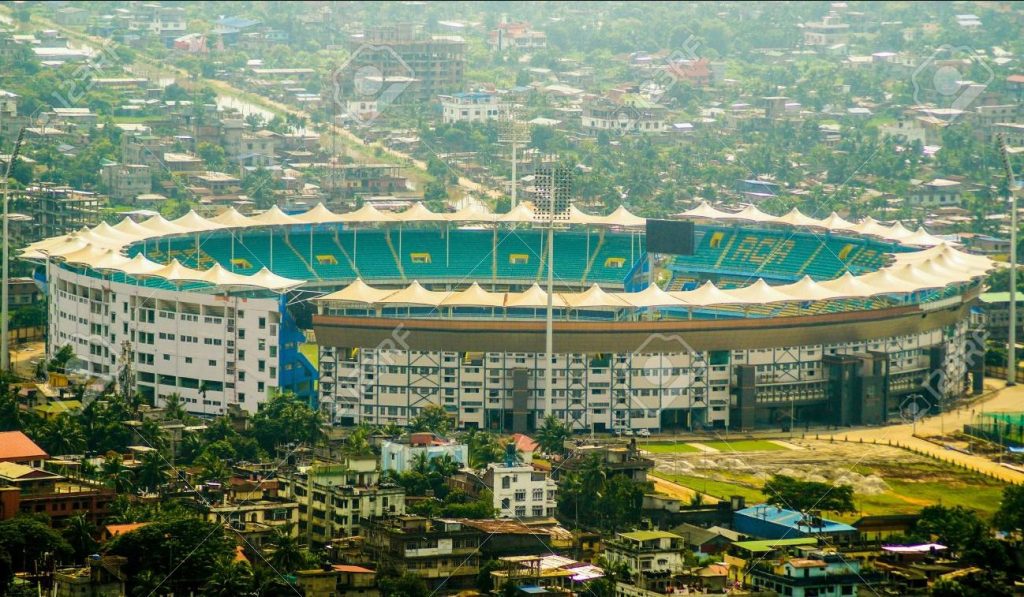The Barsapara Cricket Stadium, officially named the Dr. Bhupen Hazarika Cricket Stadium, is located in Guwahati, Assam, and is one of India’s newest international cricket venues. Since its inauguration, the stadium has gained popularity for its vibrant atmosphere and modern infrastructure. A crucial factor in assessing any cricket venue is its boundary length, which directly influences the dynamics of the game—affecting batting strategies, bowling tactics, and field placements.
This article explores the boundary dimensions of Barsapara Stadium, compares them with other major Indian grounds, and analyzes how the stadium’s size impacts both batsmen and bowlers across formats.
Quick Overview: Barsapara Cricket Stadium
| Feature | Details |
|---|---|
| Location | Guwahati, Assam |
| Official Name | Dr. Bhupen Hazarika Cricket Stadium |
| Year Established | 2012 (domestic), 2017 (international) |
| Seating Capacity | 40,000+ |
| Owner | Assam Cricket Association (ACA) |
| Ends | Pavilion End, City End |
| First T20I Match | 2017 – India vs Australia |
| First ODI Match | 2018 – India vs West Indies |
| Floodlights | Yes (four towers) |
| Surface | Red soil with decent bounce |
Boundary Dimensions of Barsapara Stadium
| Boundary Direction | Approximate Distance (in meters) |
|---|---|
| Straight | 70 – 75 m |
| Square (off-side/leg-side) | 63 – 67 m |
| Fine leg/Third man | 60 – 63 m |
| Long on/Long off | 65 – 70 m |
These dimensions classify Barsapara as a medium-sized ground, slightly on the larger side compared to many Indian T20 venues like Wankhede or Chinnaswamy.
Comparison With Other Indian Stadiums
| Stadium | Straight (m) | Square (m) | Ground Type |
|---|---|---|---|
| Barsapara, Guwahati | 70 – 75 | 63 – 67 | Medium |
| M. Chinnaswamy, Bengaluru | 65 | 59 | Small |
| Eden Gardens, Kolkata | 76 | 66 | Large |
| Wankhede Stadium, Mumbai | 68 | 63 | Small |
| Narendra Modi Stadium, Ahmedabad | 75 | 70 | Very Large |
| ACA–VDCA Stadium, Visakhapatnam | 70 | 64 | Medium |
Barsapara’s boundaries provide a balanced layout, offering opportunities for both stroke play and tight bowling, especially in day-night encounters.
Impact on Match Strategies
1. Batting Approach
Key Implications:
- Top-order batsmen aim to maximize scoring between mid-off and mid-on.
- Square boundaries require placement over power due to their slightly longer size.
- Timing becomes crucial for boundary hitting rather than brute force alone.
2. Bowling Strategies
Bowlers, particularly spinners and swing bowlers, can use the ground’s shape and size to their advantage by varying pace and length.
Key Tactics:
- Shorter boundaries behind the wicket prompt bowlers to avoid bowling too wide or too full.
- Spinners often bowl into the wind or target wider lines to make hitting across the line riskier.
- Pacers rely on slower deliveries and yorkers to minimize straight boundary chances.
Boundary Conditions: Wind, Dew, and Pitch
Wind and Weather
Dew Factor
Evening matches often experience heavy dew, which speeds up the outfield and makes the ball harder to grip, helping batsmen and making boundary hitting easier in the second innings.
Pitch Nature
The red soil surface usually offers even bounce, which can assist stroke-makers in lofting the ball safely. However, wear and tear across formats can make square boundaries more relevant for spinners.
Notable Matches and Boundary Impact
India vs South Africa, T20I – October 2022
India posted a mammoth 237/3. The match featured 16 sixes, many of which were straight hits clearing the 70+ meter boundary. This match showcased how well-timed shots could easily clear the ropes at Barsapara.
India vs West Indies, ODI – 2018
Chasing 323, the West Indies managed to tie the game. The chase was driven by middle-order batsmen who targeted square boundaries and gaps in the deep. The pitch played true, and the boundary lengths allowed for strategic placement as much as power.
Boundary Adjustment: Flexibility for Formats
| Match Format | Boundary Positioning |
|---|---|
| T20I | Ropes brought in slightly |
| ODI | Ropes set at average distance |
| Test Match | Ropes placed at maximum range |
This flexibility helps maintain fairness while ensuring the stadium complies with ICC regulations, which require a minimum boundary distance of 59.43 meters (65 yards) from the center of the pitch.
Fielding Considerations
Boundary length doesn’t just affect batsmen—it plays a major role in fielding strategy:
- Sweeper cover and deep midwicket fielders have to cover more ground due to longer square boundaries.
- Fast outfields combined with average boundary size demand agile boundary riders.
- Good throwing arms are essential to cover the straight boundaries efficiently.
Tech and Viewer Experience
The viewer experience, both in-stadium and on TV, benefits from the ground’s symmetrical design and evenly distributed boundaries, making it easy for fans to track sixes and fours in every direction.
The Barsapara Cricket Stadium in Guwahati stands out as a well-balanced venue with moderate to slightly large boundary lengths. The average straight boundaries of 70–75 meters and square sides of 63–67 meters create a level playing field for both bat and ball. Unlike some grounds that overwhelmingly favor batting, Barsapara rewards thoughtful shot selection and disciplined bowling.
Whether it’s a high-octane T20I or a strategic ODI encounter, boundary length at Barsapara plays a pivotal role in shaping match outcomes. As cricket continues to grow in India’s Northeast, Barsapara will remain central to bringing world-class cricket to new audiences—where every meter of boundary can make all the difference.


